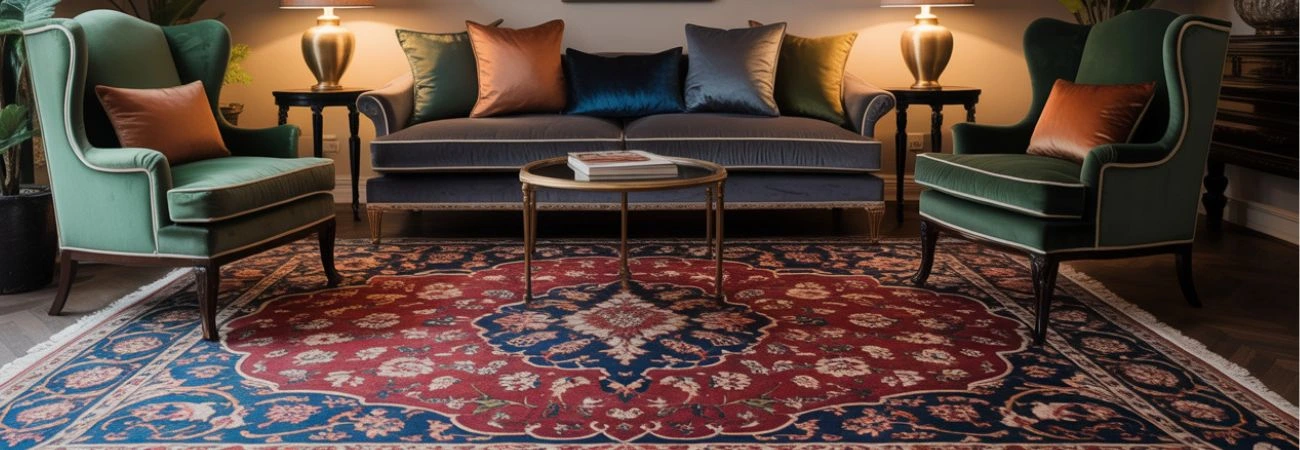What if your floor could tell you the story? Look at your Persian carpets. It is not just a handwoven craft but a masterpiece of art that reflects the history & culture of ancient civilization. Each knot of a Persian rug is woven intricately, holds the rich colors & is adorned with elegant motifs.
The inception of carpets in Persia, now Iran, dates back thousands of years, during the Nomadic period. From that era to the present, handmade Persian rugs have been influenced by distinct cultures. This has created a sophisticated beauty that not just enhances your space but also reflects the significant history it carries.
Let’s explore story behind the unique craftsmanship of Persian carpets and rugs and how they become enduring beauty, timeless luxury & one of a kind art.
The Nomadic Beginning (500 BCE and Earlier)
The story of carpet weaving begins with Nomadic tribes. These communities started weaving the carpets with insulation that provides warmth and comfort in cold weather. When the oldest rug, “Pazyryk Carpet,” came into view, it was revealed that well-crafted carpets also existed before the 5th century BCE.
- Early Purpose
Nomadic tribes used to create carpets for warmth in cold climates. They learned weaving not just for practical purposes but also for self expression.
- The Pazyryk Carpet
This is the first carpet discovered in 1947. It was preserved in a block of ice in a tomb.
- Early Status
During the Achaemenid Empire, motifs like Cyrus, symbolizing wealth & prestige, were the main characters that reflected artistic and aesthetic value.
The Sasanian Legacy: Gardens on the Floor (224-651 CE)
During this era, Persian rugs went through a legendary transformation. The famous example of this is the “Spiring of Khosro” carpet.
- Royal Luxury
The king of the Sasanians commanded a beautiful carpet to be made for his Palace. This carpet should replicate his full-blooming garden, studded with jewels and precious elements.
- A Lost Treasure
This luxurious and detailed craft was lost with the invading Arabs. However, this story has enhanced the reputation of the Persian carpets and made them magnificent with immersive power.
The Islamic Golden Age and Geometric Artistry (8th – 14th Centuries)
With the rise of Islamic culture, rug craft was also impacted by its depiction. This era introduced new motifs and techniques that carpet weavers began to use in their work.
- New Designs
Geometric patterns and calligraphy become the major elements of carpet design. This reflected the grandeur of the Islamic influence.
- Turkish Influence
In the 11th century, the Turkish Seljuk tribe introduced the “Ghiordes Knot” to weave carpets. And this technique is still used to make rugs in many regions.
The Safavid Golden Age: Pinnacle of Design (16th – 18th Centuries)
Persian designs were at their peak during this era. Under the Safavid Dynasty, weavers flourished in their art with a unified artistic identity. They combined traditional Persian, Islamic, and Central Asian styles to create a more aesthetic carpet.
- Royal Patronage
Shah Abbas I had conducted royal court workshops for artists and weavers. He was the 5th Safavid Shah of Iran and helped carpet makers to enhance their craft with precision and efficiency.
- Luxury Materials
Carpets during this era were woven from premium materials like silk and metallic threads, golden and silver threads.
- Trade and Renown
With popularity, the demand for Persian rugs and carpets was high in Europe and America. This increased the exports of carpets and helped extend the reputation worldwide.
Regional Variations: A World of Designs
Persia has diverse regional lands, and each one is distinct. Similarly, the carpets woven in different regions hold different styles and tapestries.
Table of Regional Styles
- Tabriz
Known for diverse and detailed designs.
- Isfahan
Celebrated for balanced compositions and high knot counts.
- Kashan
Prized for its classic floral patterns and central medallions.
- Qom
Known for exceptionally fine silk carpets.
- Heriz
Distinctive for bold, geometric patterns.
- Gabbeh
Rustic, tribal rugs with minimalist charm.
Modern Era: The Enduring Appeal
In late 19th century, the revival of Persian rugs and carpets brought the rug industry on track. This happened due to growing exports in the market and became greate choices for modern houses.
- Revival and Export
After periods of decline, the market rose and was strongly back on the global stage by fulfilling the European and American markets’ demands.
- Adapting to Modernity
Over time, Persian carpets and rugs have become available all over the world. Currently, these are cherished by every individual. These carpets are found in modern design and decor, reflecting the cultural heritage.
- UNESCO Recognition
In 2010, Carpet weaving was registered in UNESCO’s Intangible Cultural Heritage List.
Conclusion: A Woven Legacy
A Persian rug is a unique craftsmanship. This art form has evolved from Nomadic eras, influenced by diverse cultures. So, next time when you see a Persian carpet. You are not just looking at a decorative home furnishing but witnessing history woven into every thread.
Today, these rugs are cherished globally. You can easily find Persian carpets in Delhi, London, Dubai or other parts of the world. And invest in this one of a kind art to transform your space into a timeless beauty.
